heating BUICK ROADMASTER 1993 Owners Manual
[x] Cancel search | Manufacturer: BUICK, Model Year: 1993, Model line: ROADMASTER, Model: BUICK ROADMASTER 1993Pages: 340, PDF Size: 18.34 MB
Page 70 of 340
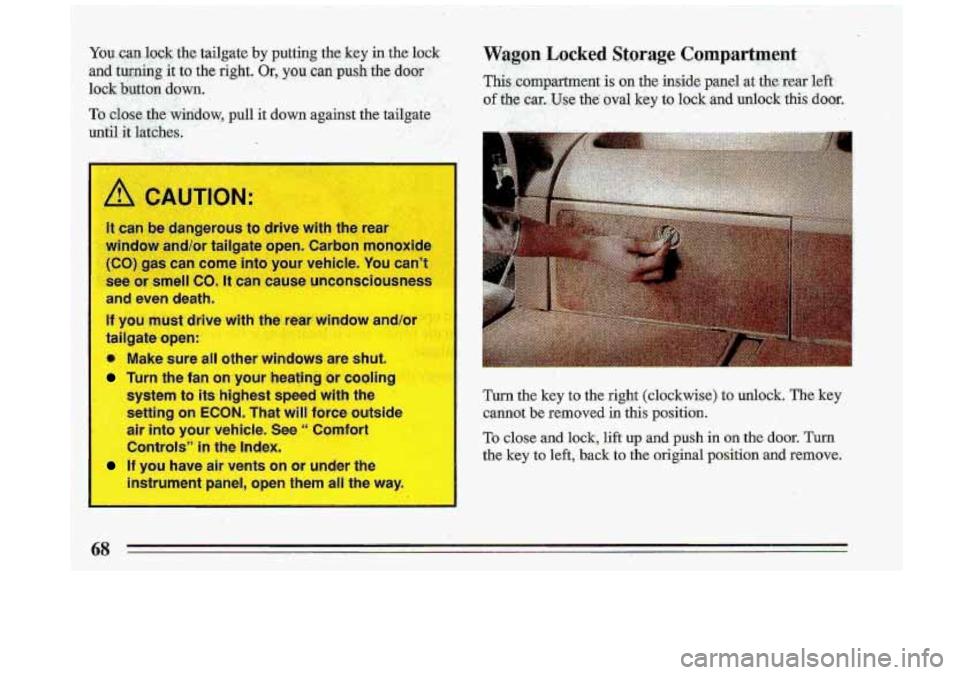
A .CAUTION-
It can be 'dangerous to drive with the rear
mrindaw, and/or tailgate open. Carbmimonoxide
(CO) ,gas can come into your vehicle. You can't
see
03 smell co. It can -use unconsciousness
and even death.
If you must driv- ---'*,- 'he rer ---'xiow and/c
tailgate open:
Make sure al
Turn the fan on your heating or coolin!
system to
its highest speed with the
setting on
ECON. That will force outsic
Controls"
in the Index.
instrumen
ban open them a he way.
. . air into your vehicle. See '' Comfort
If you have air vents on or under the
Turn the key to the right (clockwise) to.unlock. The key
cannot be removed in this position.
To close and lock, lift up and push in on the door. Turn
the kev to left, back to the original position and remove.
68
Page 124 of 340
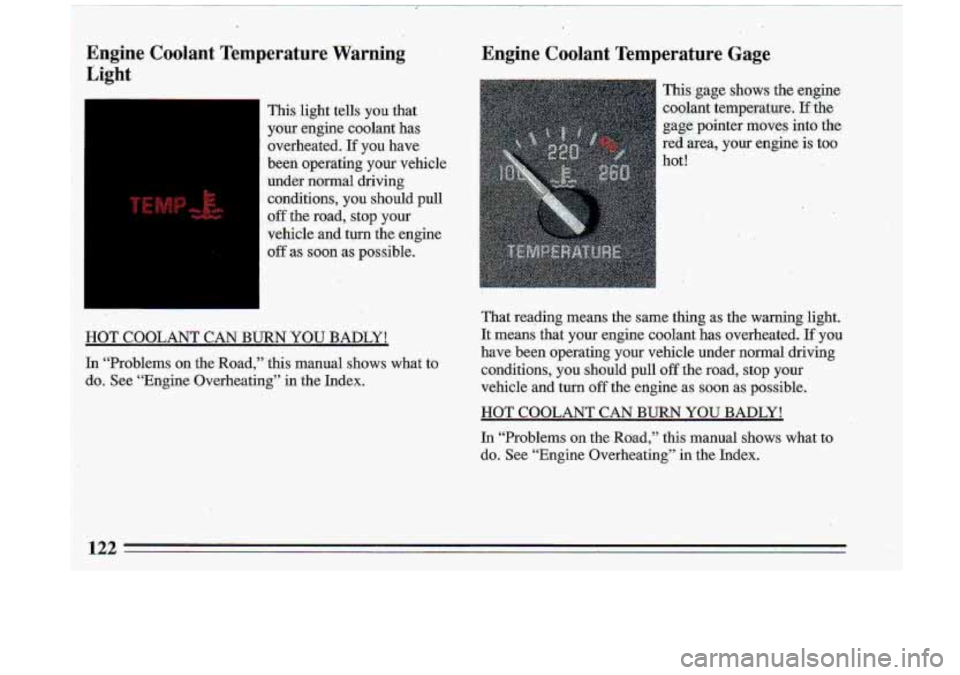
Engine Coolant Temperature Warning: ’ J
Light
1
I
This light tells you that ‘
your engine coolant has
ovetheated.
If you have
been operating your vehicle
under normal driving
.conditions, you should pull
off the road, stop your
vehicle and
turn the engine
-off as soon as possible.
:I
HOT COOLANT CAN BURN YOU-BADLY!
In “Problems on the Road,” this manual shows what to
do. See “Engine Overheating” in the Index.
Engine Coolant Temperature Gage
This gage shows the engine
coolant temperature,
If the
gaie: pointer moves into the
red area, your engine is too
hot!
: y’,
That reading means the same thing as the warning light.
It means that your engine coolant has overheated.
If you
have been operating your vehicle under normal driving.
conditions, you should pull off-the road, stop your
vehicle and
turn off the engine as soon as possible.
HOT COOLANT CAN BURN YOU BADLY!
In “Problems on the Road,” this manual shows what to
do. See “Engine Overheating” in the Index.
133
Page 135 of 340
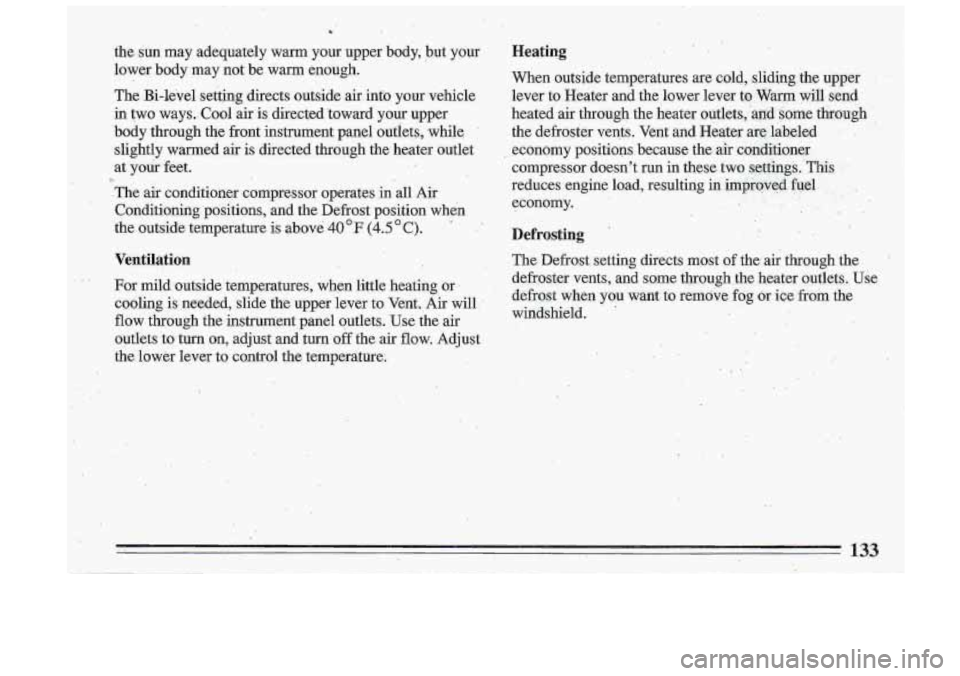
i
the sun may adequately warm your upper body, but your
lower body may not be warm enough.
The Bi-level settbg directs outside air.into your vehicle
in two ways.-Cool air
is directed 'toward your upper
body through the front instrument panel outlets, ,while
slightly warmed
air is directed through the heater outlet
at
your feet.
.The air conditioner compressor operates in all Air
Conditioning positions, and the Defrost position when
.the outside temperature is above
40 OF (4.5 C).
R
Ventilation
For mild outside temperatures, when little heating ox ,
cooling is needed, slide the upper lever to Vent, Air will,'
flow through the .instrument panel outlets. Use the air
oudets to turn on, adjust and turn
off the air, flow. Adjust.
the lower lever to control the temperature;
'.
.. .
Heating
When outside temperatures are cold, 8liding:the upper .
lever to Heater and the' lower lever to :Warm will send,
heated air though the heater outlets, 'and-some through
the defroster vents. Vent and Heater arelabeled
economy positions. because the
dr conditioner
compres.sor doesn't run in these..two settings. "This . .
reduces engine load, resulting in impioyed I.. fyd.
economy.
Defrosting
The Defrost setting directs most of the- air through the
defroster vents, and some through.the heater outlets. Use
defrost when you want to remove fog
,6r ice from the
windshield.
133
Page 205 of 340
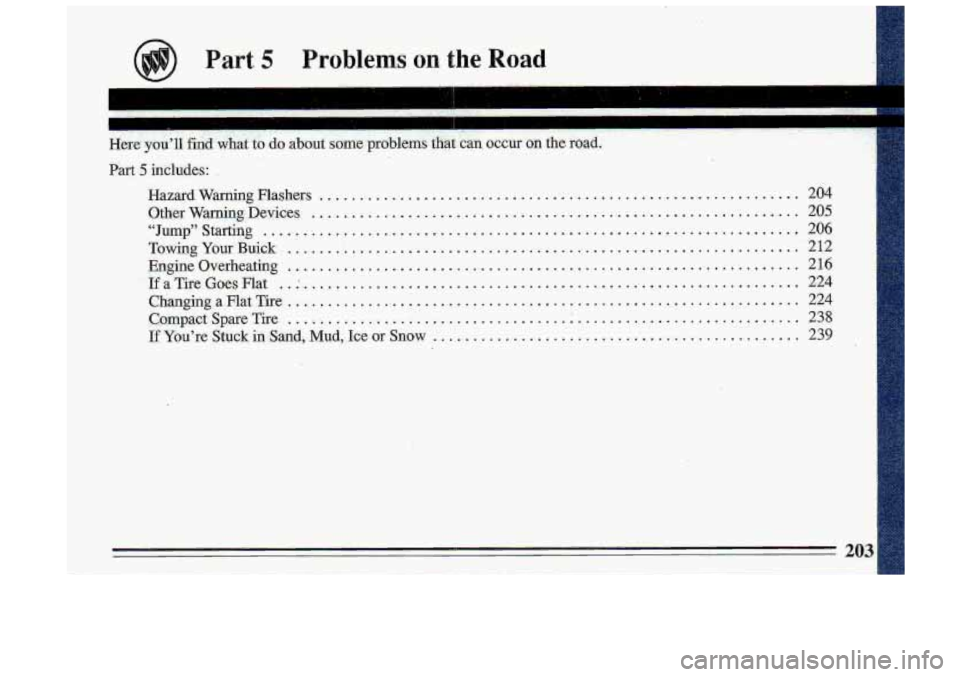
Part 5 Problems on the Road
I- .. . 1. ’ . ’ ‘I
.. .....
Here you’ll find what to do about some problems that can occur on the road .
Part 5 includes:
Hazard Warning Flashers
............................................................
“Jump”Starting ...................................................................
OtherWarningDevices .............................................................
TowingYourBuick ................................................................
Engineoverheating ................................................................
IfaTireGoesFlat .................................................................
ChangingaFlatTire ................................................................
CompactSpareTire ................................................................
If You’re Stuck in Sand, Mud, Ice or Snow ..............................................
204
205
206
212
216
224
224
238
239
Page 274 of 340
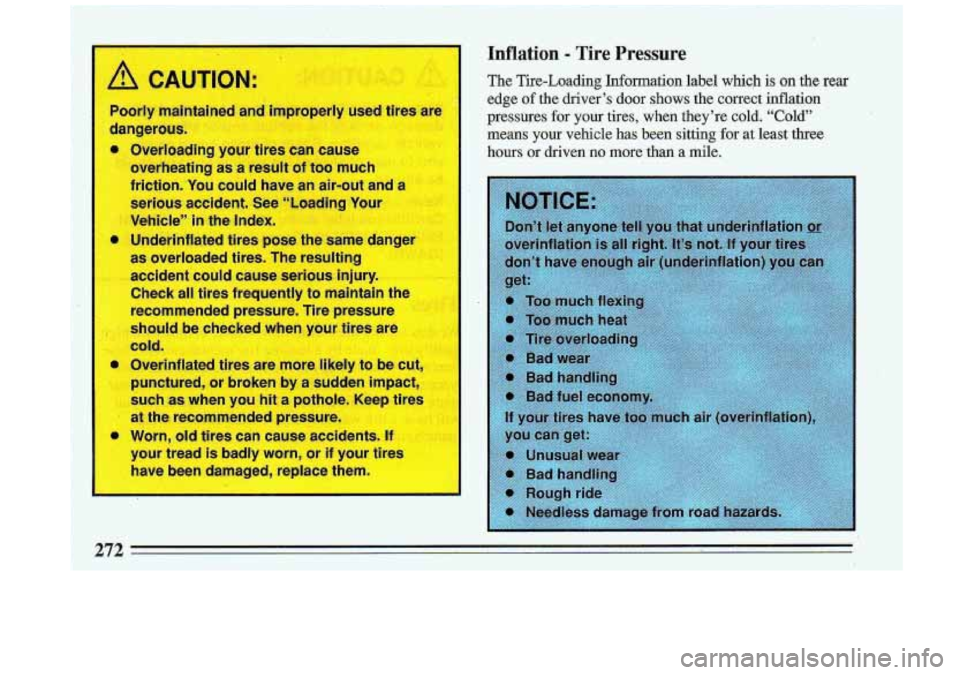
ION
)orly maintained and improper1
dangerous.
Overloading
- 3ur tires can caus [sed
tires are
e
overheating as a result
of too much
friction:You could have an air-out ant
serisws accident. See -“Loading Your
Vehicle”
in the Inde:
Underinflated tires
pose the same dangc
as overloaded tires. The resulting
accident’could cause serious injury.
Check
all tires frequently to maintain a I
recommended pressure. Tire pressure
sha I be checked when your tires are
cold
Overinflated tires are more likely to be cut,
punctured, or broken
by a sudden impact,
such as when
you hit a pothole. Keep tires
at the recommended pressure
Worn, old tires can cause accidents.
I,
your tread is badly worn, or if your tires
have been damaged, replace them.
Inflation - Tire Pressure
The Tire-Loading Information label which is on the rear
edge of the driver’s door shows the correct inflation
pressures
for your tires, when they’re cold. “Cold”
means your vehicle
has been sitting for at least three
hours or driven no more than a mile.